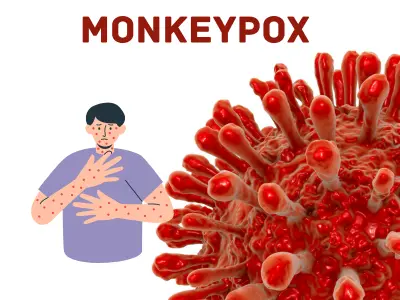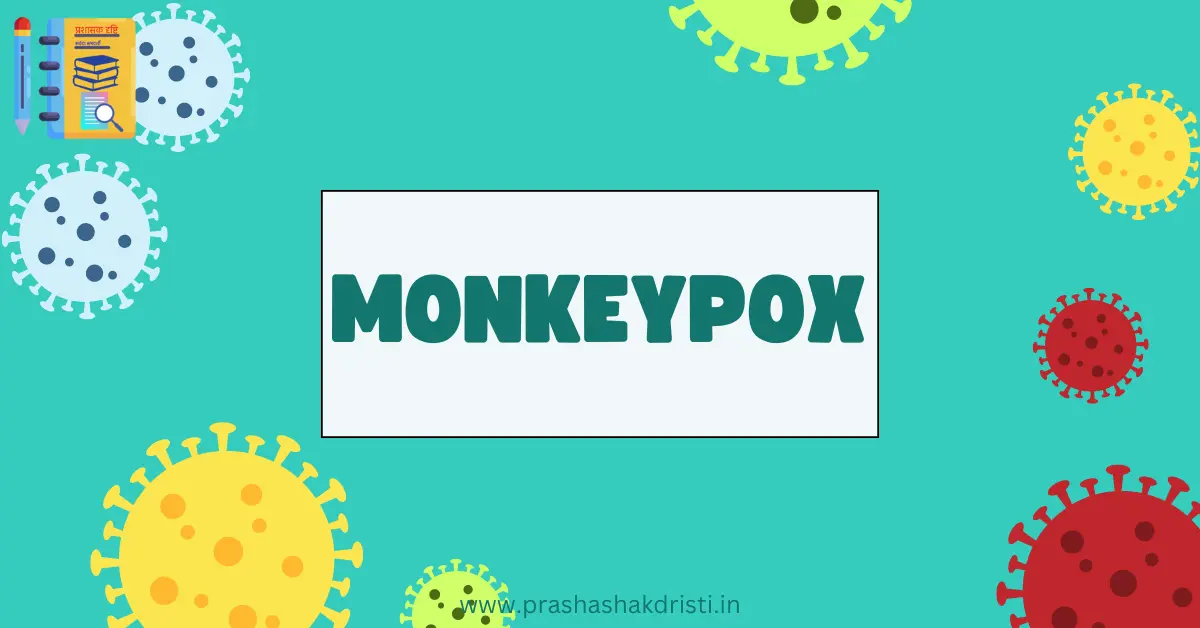Monkeypox is a rare viral disease. Monkeypox India was initially identified in 1958 during two outbreaks among groups of monkeys that were being studied for research purposes. The first known human case of the disease was documented in 1970 in the Democratic Republic of the Congo. While the disease was initially confined to Africa, recent outbreaks in non-endemic countries have raised global concerns, including in India.
What is Monkeypox?

This virus is caused by the monkeypox virus, a member of the Orthopoxvirus genus, which also includes the variola virus that causes smallpox. The disease presents symptoms similar to smallpox but is generally less severe. Monkeypox can affect both humans and animals. It is a zoonotic illness, which means it has the ability to transfer from animals to humans.
Symptoms of Monkeypox
The symptoms of this virus are similar to those of smallpox but are usually milder. They typically appear within one to two weeks after exposure to the virus. The initial symptoms include:
- Fever
- Headache
- Muscle aches
- Back pain
- Swollen lymph nodes
- Chills
- Exhaustion
Within a few days of the fever, a rash typically develops. The rash starts on the face and then spreads to other parts of the body, including the palms of the hands and the soles of the feet. The rash goes through different stages, starting as flat lesions, then becoming raised, filled with fluid, and finally forming scabs. Usually This illness lasts 2 to 4 weeks.
Transmission of Monkeypox
This virus spreads in several ways. The most common mode of transmission is through direct contact with the blood, bodily fluids, or skin lesions of infected animals or humans. It can also spread through respiratory droplets during prolonged face-to-face contact or by touching objects, such as bedding or clothing, that have been contaminated with the virus.
Animal-to-human transmission occurs through bites or scratches from infected animals, or by handling bushmeat. Human-to-human transmission, although less common, can occur through close contact with an infected person.
Monkeypox in India
India has reported several cases of this virus, especially during the global outbreak in 2022. The cases were mostly found in individuals with a travel history to affected countries. The first case in India was detected in July 2022 in Kerala. Since then, more cases have been reported across different states, causing public concern and prompting health authorities to take action.
Government Respose to Monkeypox
The Indian government has been proactive in responding to the this virus threat. The Ministry of Health and Family Welfare (MoHFW) issued guidelines for the management and prevention of monkeypox. These guidelines include:
- Surveillance and contact tracing to identify and isolate potential cases.
- Setting up diagnostic facilities for quick detection of the virus.
- Training healthcare workers to recognize symptoms and manage cases.
- Public awareness campaigns to educate people about the disease and its prevention.
The government has also collaborated with international health organisations like the World Health Organization (WHO) to monitor the situation and implement best practices for containment.
Diagnosis of Monkeypox
Diagnosing this virus can be challenging, especially in non-endemic areas like India, where the disease is not common. Healthcare professionals rely on the patient’s history, including travel and contact history, and clinical symptoms to suspect this virus.
Laboratory confirmation is essential for an accurate diagnosis. This involves:
- Polymerase Chain Reaction (PCR) tests to detect the virus’s DNA in skin lesions or blood.
- Virus isolation from samples, although this is less commonly done due to its complexity.
Note – Please take your Doctor’s advice for Diagnossis Related to Monkeypox !
Treatment of Monkeypox India
There is no specific treatment for this virus. The management of the disease is mainly supportive, focusing on relieving symptoms and preventing complications. This includes:
- Hydration to prevent dehydration from fever.
- Pain relief for headaches, muscle aches, and other discomforts.
- Antibiotics if secondary bacterial infections occur.
In some cases, antiviral medications like Tecovirimat (ST-246) have been used under compassionate use protocols, but their availability is limited. Vaccination against smallpox has also shown some effectiveness in preventing monkeypox, but it is not widely available in India.
Note – Please take your Doctor’s advice for treatment of this virus !
Prevention of Monkeypox India
Preventing this virus involves several strategies. Public awareness is crucial in educating people about the disease and how it spreads. The following preventive measures are recommended:
- Avoiding contact with animals that could carry the virus, especially in areas where monkeypox is known to occur.
- Practising good hygiene, such as washing hands with soap and water after contact with animals or infected individuals.
- Using personal protective equipment (PPE) when caring for patients with suspected or confirmed monkeypox.
- Separating infected individuals to stop the virus from spreading to others.
- Vaccination in some cases, especially for healthcare workers or those at high risk of exposure.
Challenges in Combating Monkeypox in India
India faces several challenges in combating this virus. These include:
- Limited Awareness: Many people are unaware of this virus, its symptoms, and how it spreads. This lack of knowledge can delay diagnosis and increase the risk of transmission.
- Healthcare Infrastructure: While India has made significant strides in healthcare, the infrastructure in some regions may not be equipped to handle emerging diseases like monkeypox.
- Stigma and Fear: Infectious diseases often carry a social stigma, leading to fear and discrimination. This can discourage individuals from seeking medical help or disclosing their symptoms.
Role of the Common People
The public plays a crucial role in preventing the spread of this virus. Awareness and education are key to controlling the outbreak. Individuals should:
- Stay informed about the disease and follow government guidelines.
- Report any symptoms to healthcare professionals immediately.
- Cooperate with contact tracing efforts to help identify and isolate cases.
Conclusion
Monkeypox is a serious disease that requires attention and action, especially with its recent emergence in India. While the government and healthcare authorities are taking steps to manage and prevent the spread of the virus, public awareness and cooperation are equally important. By understanding the disease, recognizing its symptoms, and following preventive measures, India can effectively control the outbreak and protect its population from this emerging threat.
Dear Visitor, You can also Read About- Hema Committee Report
FAQs
What is monkeypox, and how does it differ from smallpox?
This virus is a viral infection caused by the monkeypox virus, which is similar to the smallpox virus but generally less severe. While both diseases cause similar symptoms like fever and rash, monkeypox is less contagious and less deadly than smallpox.
How does monkeypox spread among humans?
This virus spreads through direct contact with the bodily fluids, blood, or skin lesions of an infected person or animal. It can also spread through respiratory droplets during close face-to-face contact or by touching contaminated objects like bedding or clothing.
What are the common symptoms of monkeypox?
Common symptoms of monkeypox include fever, headache, muscle aches, back pain, swollen lymph nodes, chills, exhaustion, and a rash that usually starts on the face and spreads to other parts of the body.
Is monkeypox deadly?
This virus is generally less severe than smallpox, with most patients recovering fully. However, it can be serious, especially in individuals with weakened immune systems, children, or those with underlying health conditions.
How can I protect myself from monkeypox?
You can protect yourself from this virus by avoiding contact with animals that could carry the virus, practicing good hygiene, using personal protective equipment when necessary, and following public health guidelines.
Has monkeypox been reported in India?
Yes, this virus cases have been reported in India in the month of march 2024, especially during the global outbreak in 2022. In 2022 the cases were mostly linked to individuals with travel histories to affected regions.
What should I do if I suspect I have monkeypox?
If you suspect you have this virus, you should seek medical attention immediately. Isolate yourself from others to prevent spreading the virus and follow the advice of healthcare professionals.
Is there a vaccine for monkeypox?
There is no specific vaccine for monkeypox, but the smallpox vaccine has shown effectiveness in preventing monkeypox. However, the smallpox vaccine is not widely available in India.
How long does it take to recover from monkeypox?
Recovery from this virus typically takes 2 to 4 weeks. The disease usually resolves on its own, but supportive care may be needed to manage symptoms and prevent complications.
What is the Indian government doing to control mpox virus?
The Indian government has issued guidelines for managing and preventing this virus, including surveillance, contact tracing, public awareness campaigns, and training for healthcare workers. The government is also collaborating with international health organizations to monitor the situation.

